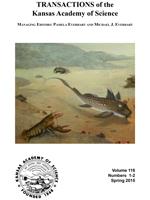The plains harvest mouse (Reithrodontomys montanus) is an uncommon small mammal that primarily occurs in herbaceous habitats in the Great Plains. To better understand its ecology and natural history in north-central Kansas, we examined observations of this small prairie mouse in a variety of native and anthropogenic habitats over a geographically widespread area (>200 sites) in the Smoky Hills region of Russell and Lincoln counties during 1976–2003 [total trap nights (TN) was ca. 100,000]. Habitats sampled by snap traps or live traps included native upland prairie and limestone breaks prairie, planted grasslands, old fields, crop fields (primarily wheat fields), fallow fields, fencerows, hay fields and roadside ditches. Sampling schemes generally included 4 nights of trapping along standard traplines at specific sites that were sampled only once as well as multipleyear designs that used live traps and standard traplines or a 10.8 ha grid at specific sites for 2–5 year duration. Plains harvest mice (n = 50) were captured at only 20 sites (<10% of all sites sampled); overall, we captured ca. 0.5 individuals/1,000 TN. Plains harvest mice were captured in four general habitats: native prairie, grasslands planted with native seeds, fallow fields and wheat stubble. These mice selected arid soils where sparse vegetation and mulch occurred, more specifically grazed upland prairie, but not grazed limestone break sites. Overall, sex ratio neither differed from a 1:1 ratio (23 males and 27 females) nor among seasons. Also, sampling of males and females was not affected by trap type (live versus snap); however, males exhibited a greater initial neophobic response to traps than did females. Body mass of plains harvest mice ranged from 6.5 g to 13.5 g; non-pregnant females (10.2 g) were significantly larger than males (8.3 g; males were only about 80% of female size). In contrast, skeletal size based on body length was similar between males and females; males were 98% of the body length of non-pregnant females. Reproductive females were captured between mid-April and late November. Furthermore, summer months (June–August) appeared to be a major reproductive period as ∼70% of captured females were pregnant and lactating. The mean litter size was 4.2 ± 0.34 (range 3–5); litter size increased with an increase in body length of females.
How to translate text using browser tools
1 April 2015
Plains Harvest Mice in North-Central Kansas: Abundance, Habitat Association and Individual Attributes
Donald W. Kaufman,
Glennis A. Kaufman
ACCESS THE FULL ARTICLE
abundance
anthropogenic habitats
body size
native mixed grass prairie
Reithrodontomys montanus
reproduction
sex ratio





